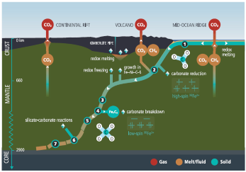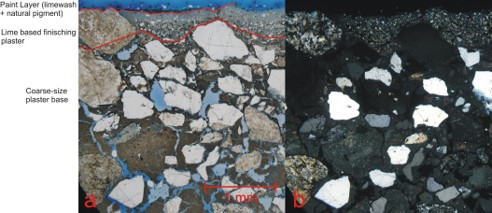
RESEARCH GROUP – PETROLOGY & PETROGRAPHY
Team:
 |
 |
 |
 |
| LUSTRINO Michele | MOLLO Silvio | RONCA Sara | STAGNO Vincenzo |
Topics:
 Diamond included in an eclogitic garnet from the Udachnaya kimberlite deposit (Russia)
Silica-Magnesia-Lime triangular plot showing some of the stable mineral paragenesis that can form during progressive metamorphism of siliceous limestone and dolostone: CaMgSi2O6 + Mg2SiO4 + 2CaCO3 = 3CaMgSiO4 + 2CO2. SiO2 = quartz or its polymorphs; MgO = Periclase; CaO = Calcite; Di = Diopside; Fo = Forsterite; Mon = Monticellite. From: Bowen (1940, J. Geol.) |
We investigate important petrological processes occurring from the Earth’s interior to the surface and governing the geochemical evolution of mantle-to-crustal rocks via partial melting, fractional crystallization, crust assimilation and magma mixing. Our research in the field of igneous and metamorphic petrology focuses on diverse aspects such as 1) potassic-ultrapotassic magmatism, 2) ultramafic systems and metasomatic processes in the upper mantle, 3) alkaline, carbonatite and tholeiitic igneous rocks, 4) redox state of peridotitic and eclogitic mantle xenoliths, 5) origin of (sub-)lithospheric diamonds.
|
|
Our research in the field of experimental petrology is carried out using several devices such as multi anvil presses, diamond anvil cells, piston cylinder and gas-mixing furnaces that allow to reproduce pressures, temperatures, volatile contents, and oxygen fugacities from depths of the lower mantle up to the crust.
|
 The deep carbon cycle and its various forms from solid (carbonates and its polymorphs), to liquid (magmas enriched in CO2) to gaseous (methane, CO2, CO and aromatic compounds) |
 Assessment of the state of conservation of historical buildings through transmitted polarised light microscopy. Optical micrographs obtained on a polished cross-section of a plaster base. a: Plane polarised light and b: cross-polarised light |
We focus on the shallow to deep volatile cycle and model its effect on mineral-melt equilibria, major and trace element partitioning, crystal growth and melt viscosity and differentiation under variable cooling-decompression conditions. We also study the characterization, petrography and weathering effects on decorative stone materials of interest for Cultural Heritage.
|


